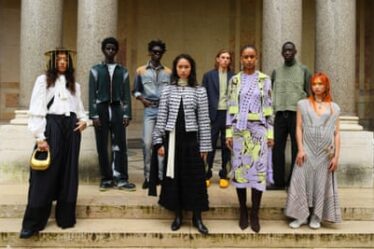
They are stained, crushed and yellowing but Balenciaga’s range of “worn-out” sneakers, launched in collaboration with Adidas this month, have sold out. This is despite an eye-watering price tag of almost £700.
The brand-new shoes, described by one reviewer as “looking like they’ve been flattened by a 20-ton steamroller”, are no longer available on the Balenciaga website, and are being priced on one specialist sneaker auction site at £2,500.
They may look as if they have seen better days but the trainers – a pair of Adidas Destroyed Stan Smiths – are, in fact, made of luxurious lambskin leather. Were they to actually reach stores, they would be on sale in Britain’s most upmarket shopping streets. Such is the demand that on Adidas’s website they will be available on 15 December with a raffle system in place.
Balenciaga is not the only brand to have made distressed trainers. Gucci created a pair of dirty-on-purpose trainers in 2019, which are on sale on its website for £715. Golden Goose has long made these types of sneakers: a design called the Superstar Taped Sneaker in 2018 was deemed particularly offensive. “I think peak capitalism is selling shoes characteristic of those who can’t afford new ones for $530,” wrote one Twitter user. Four years later, in the midst of a cost of living crisis, this feeling may have increased.
These items could be seen as the influence of the secondhand market, valued at $35b (£28bn) in 2021, up from $11bn a decade ago. Perhaps the difference here is that Balenciaga has used Stan Smiths – a relatively affordable, accessible design. They have “destroyed” them, and made them luxury, all at the same time.
Distressed clothing is by no means new. In fact, the distressed look often coincides with recessions. See the ripped and destroyed punk style in the 70s, or the downbeat grunge of the 90s. Helmut Lang pioneered the designer distressed look in this decade. He sent “painter” jeans down the catwalk in 1998, splattered with spots of emulsion.
Luca Solca, the senior research analyst of global luxury goods at Bernstein, says the worn-out sneaker is the latest product in Balenciaga’s rise. “It is more frequent to find, every now and then, a ‘hero product’,” he says “but to build a long successful series as Balenciaga has done is rather rare.”
Solca believes Balenciaga still stands apart from other brands. “One of the traits of the Balenciaga reinvention – from what I understand – has been to take the lead on irony,” he says. “The lookalike Ikea shopping bag is just one example.” In 2017, the brand released a £1,705 bag that looked like Ikea’s 75p Frakta. The irony often comes from turning something very prosaic into a hyped luxury item. These products also typically work well for memes on social media.
Balenciaga, with the designer Demna (who goes only by his first name) at the helm, is one of the biggest fashion success stories of the last few years. The brand grew by 44% between 2020 and 2021, and its parent company, Kering, reported in October that sales were “particularly buoyant across all product categories”. StockX, the resale platform, reports that there were more than 50,000 searches for the brand this year.
Notably, the age of luxury consumers is getting younger. A Bain & Company report released this month found that the Gen Z and millennial demographics were driving luxury in 2022, a sector that is forecast to grow by 21% in 2022. This demographic will probably appreciate Balenciaga’s meme-worthy irony.
The brand hit the headlines earlier this year with the Paris sneaker, one so destroyed that it would have been impossible to wear. The worn-out shoe follows the September fashion show, where models walked down a runway covered in mud, some carrying a ripped teddy bear wearing an S&M outfit “handbag”. The brand was forced to apologise this week for adverts that featured children holding the teddy bear handbags, and an image of a handbag on a desk covered with legal documents detailing a child abuse case.
Andrew Groves, a professor of fashion design at the University of Westminster, certainly sees items such as Balenciaga’s worn-out sneakers as problematic. “[They] are emblematic of what fashion historian Emma McClendon calls ‘vacationing in poverty’,” he says. He adds that, after the scandal over the adverts this week: “I think the tide has firmly turned against Balenciaga’s dystopian vision of fashion.”



